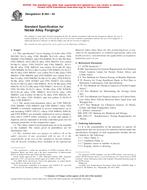1.1 This practice describes a procedure for calibrating the electron binding-energy (BE) scale of an X-ray photoelectron spectrometer that is to be used for performing spectroscopic analysis of photoelectrons excited by unmonochromated aluminum or magnesium Kα X-rays or by monochromated aluminum Kα X-rays.
1.2 The calibration of the BE scale is recommended after the instrument is installed or modified in any substantive way. Additional checks and, if necessary, recalibrations are recommended at intervals chosen to ensure that BE measurements are statistically unlikely to be made with an uncertainty greater than a tolerance limit, specified by the analyst, based on the instrumental stability and the analyst’s needs. Information is provided by which the analyst can select an appropriate tolerance limit for the BE measurements and the frequency of calibration checks.
1.3 This practice is based on the assumption that the BE scale of the spectrometer is sufficiently close to linear to allow for calibration by measurements of reference photoelectron lines having BEs near the extremes of the working BE scale. In most commercial instruments, X-ray sources with aluminum or magnesium anodes are employed and BEs are typically measured over the 0–1000 eV range. This practice can be used for the BE range from 0 eV to 1040 eV.
1.4 The assumption that the BE scale is linear is checked by a measurement made with a reference photoelectron line or Auger-electron line that appears at an intermediate position. A single check is a necessary but not sufficient condition for establishing linearity of the BE scale. Additional checks can be made with specified reference lines on instruments equipped with magnesium or unmonochromated aluminum X-ray sources, with secondary BE standards, or by following the procedures of the instrument manufacturer. Deviations from BE-scale linearity can occur because of mechanical misalignments, excessive magnetic fields in the region of the analyzer, or imperfections or malfunctions in the power supplies. This practice does not check for, nor identify, problems of this type.
1.5 After an initial check of the BE-scale linearity and measurements of the repeatability standard deviation for the main calibration lines for a particular instrument, a simplified procedure is given for routine checks of the calibration at subsequent times.
1.6 This practice is recommended for use with X-ray photoelectron spectrometers operated in the constant-pass-energy or fixed-analyzer-transmission mode and for which the pass energy is less than 200 eV; otherwise, depending on the configuration of the instrument, a relativistic equation could be needed for the calibration. The practice should not be used for instruments operated in the constant-retardation-ratio mode at retardation ratios less than 10, for instruments with an energy resolution above 1.5 eV, or in applications for which BE measurements are desired with tolerance limits of ±0.03 eV or less.
1.7 On instruments equipped with a monochromated aluminum Kα X-ray source, a measurement of the position of a specified Auger-electron line can be used, if desired, to determine the average energy of the X-rays incident on the specimen. This information is needed for the determination of modified Auger parameters.
1.8 The values stated in SI units are to be regarded as standard. No other units of measurement are included in this standard.
Product Details
- Published:
- 11/01/2010
- Number of Pages:
- 16
- File Size:
- 1 file , 380 KB
- Redline File Size:
- 2 files , 660 KB


